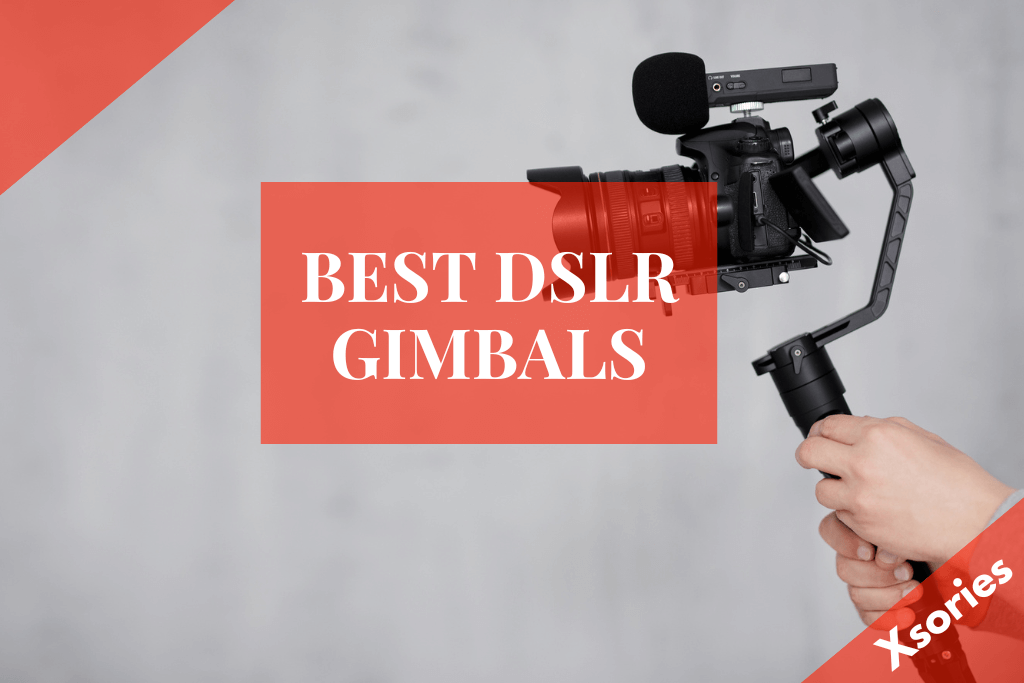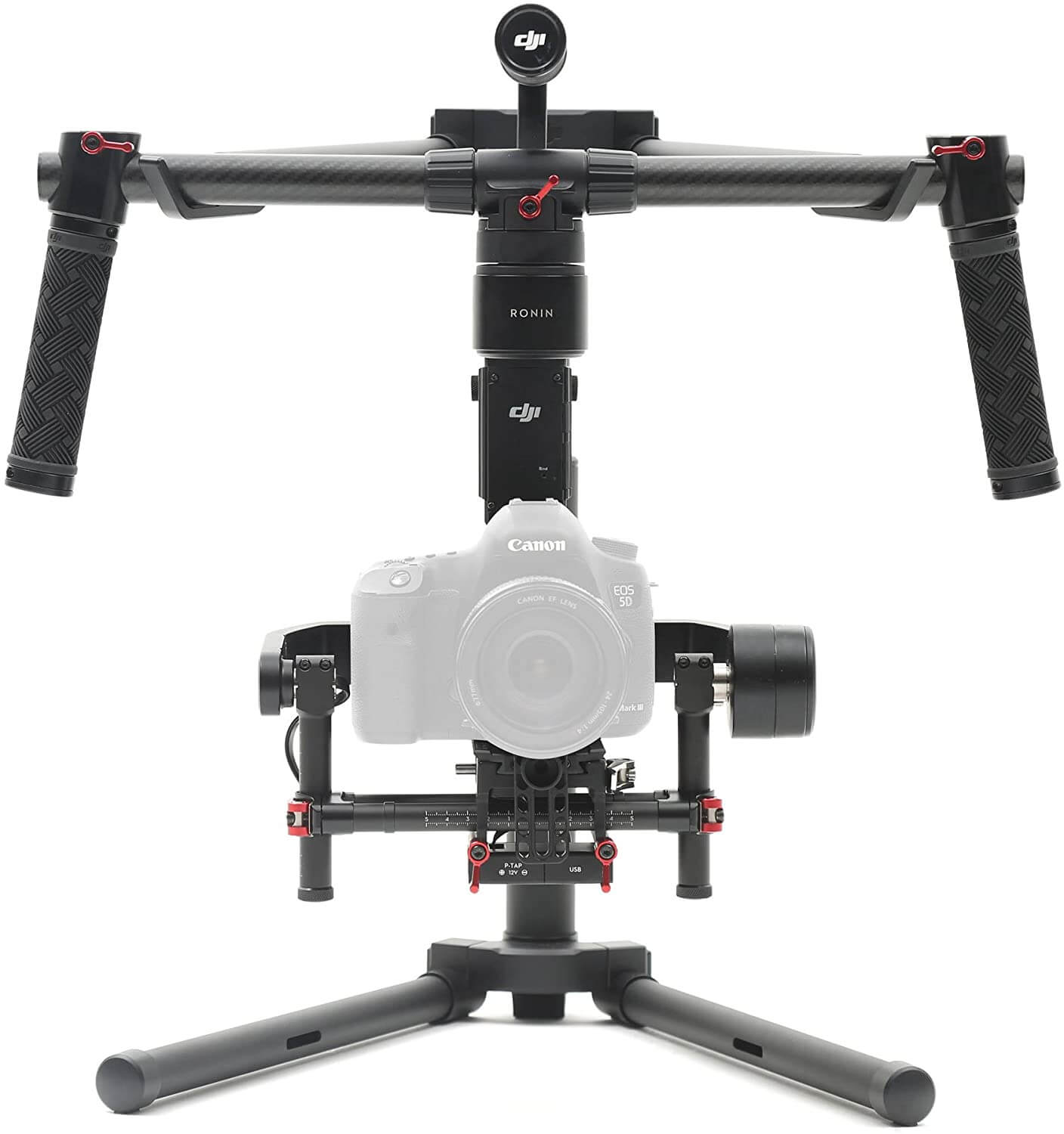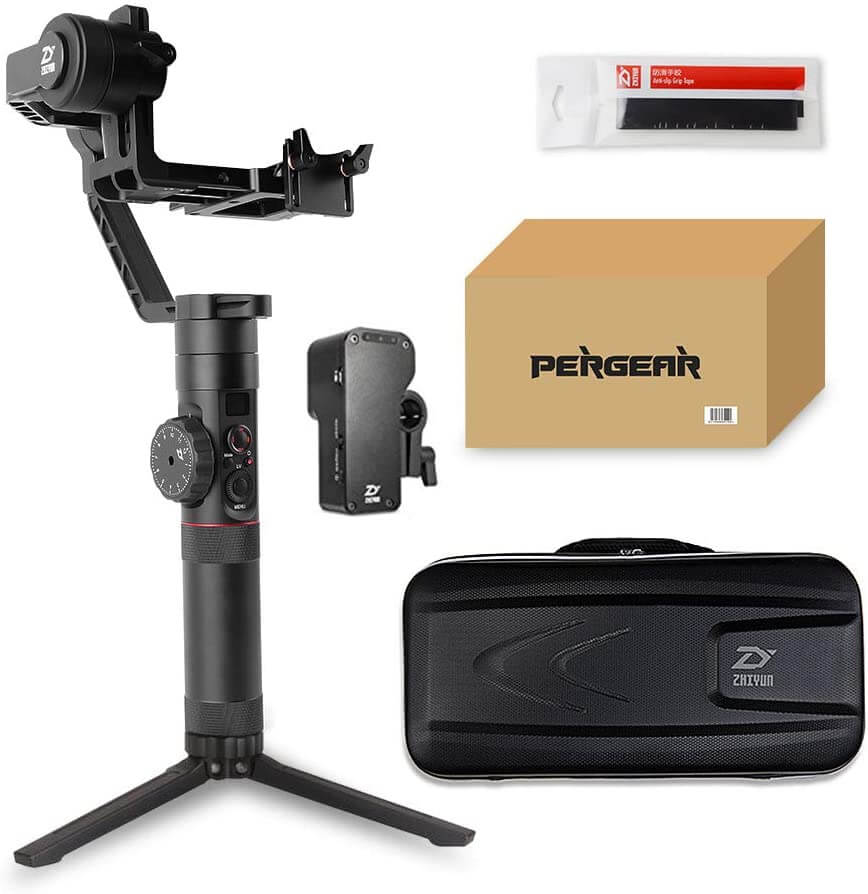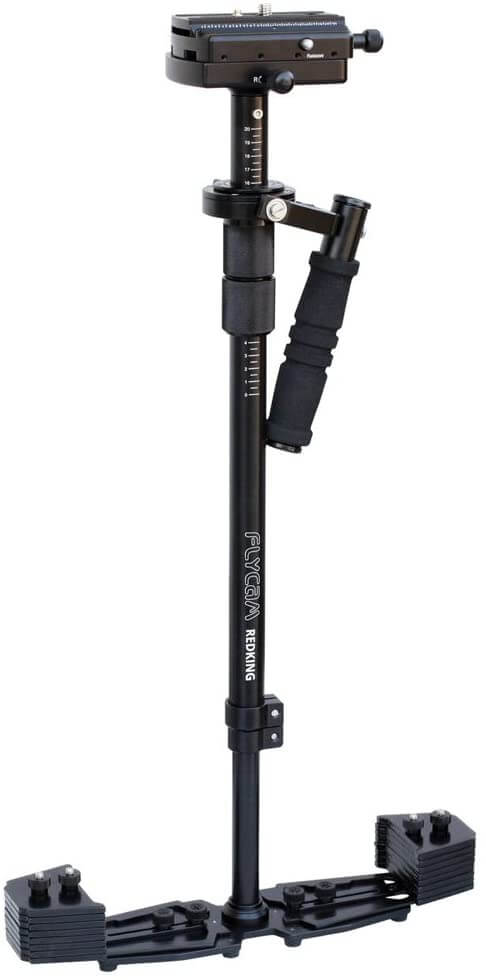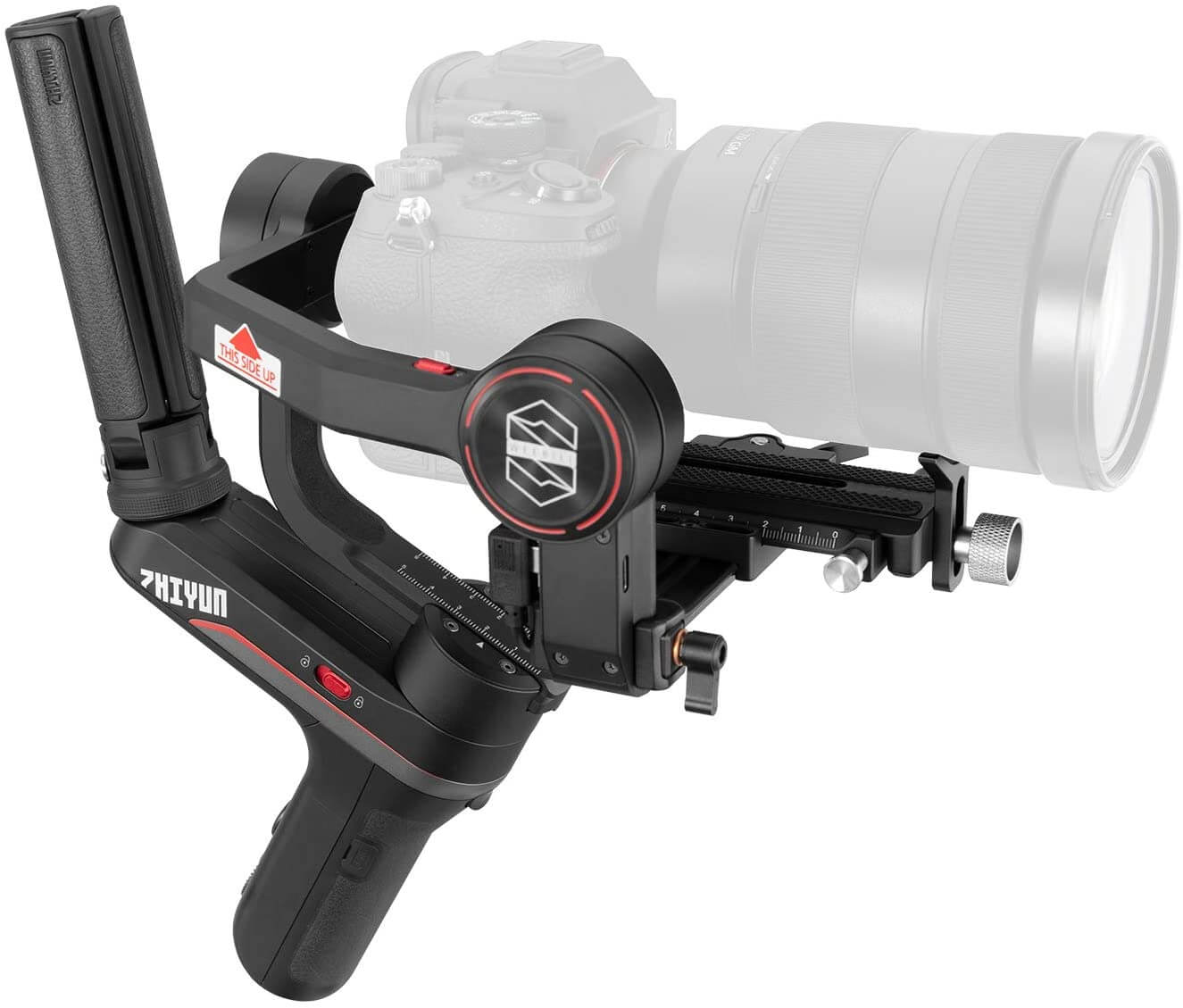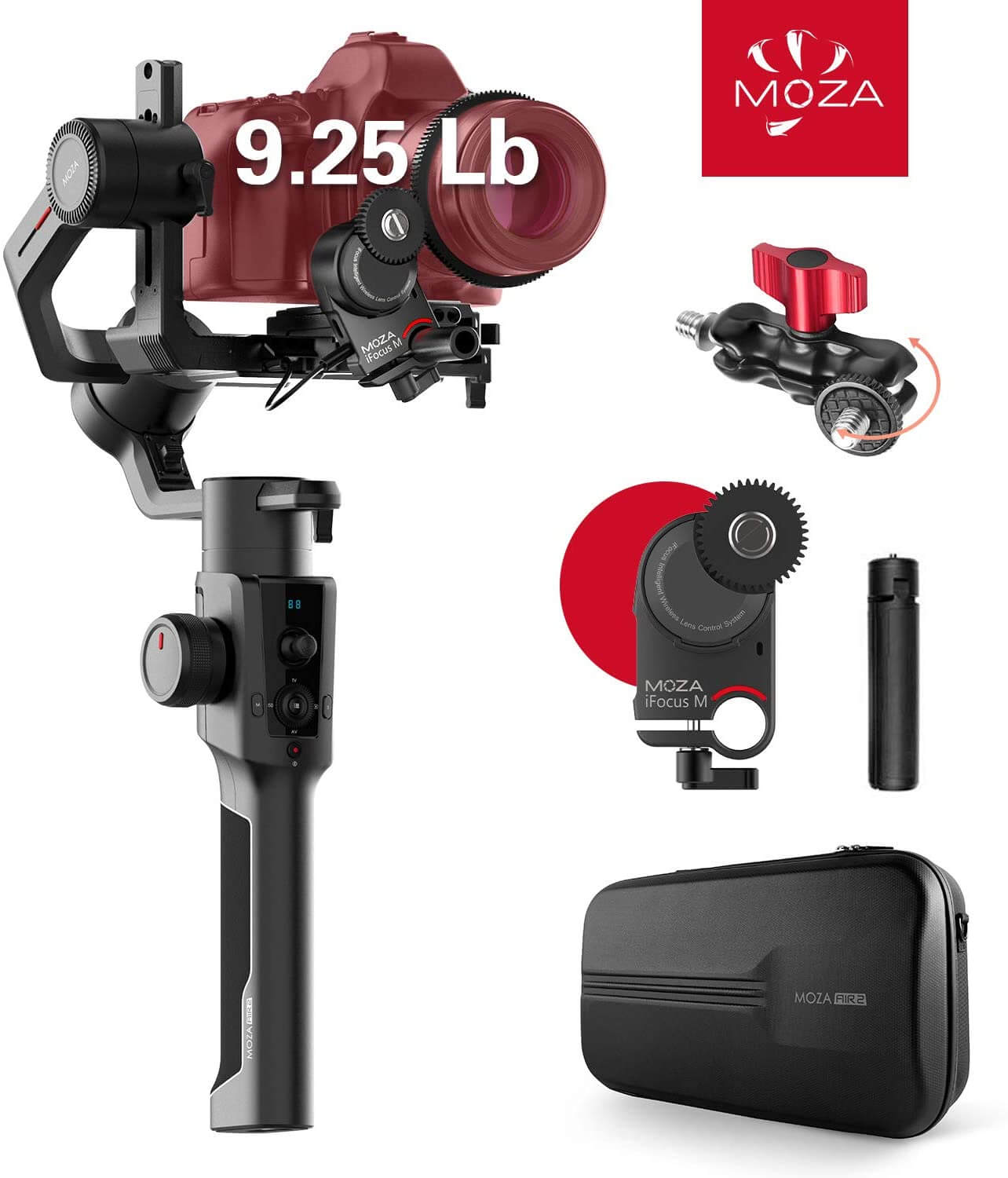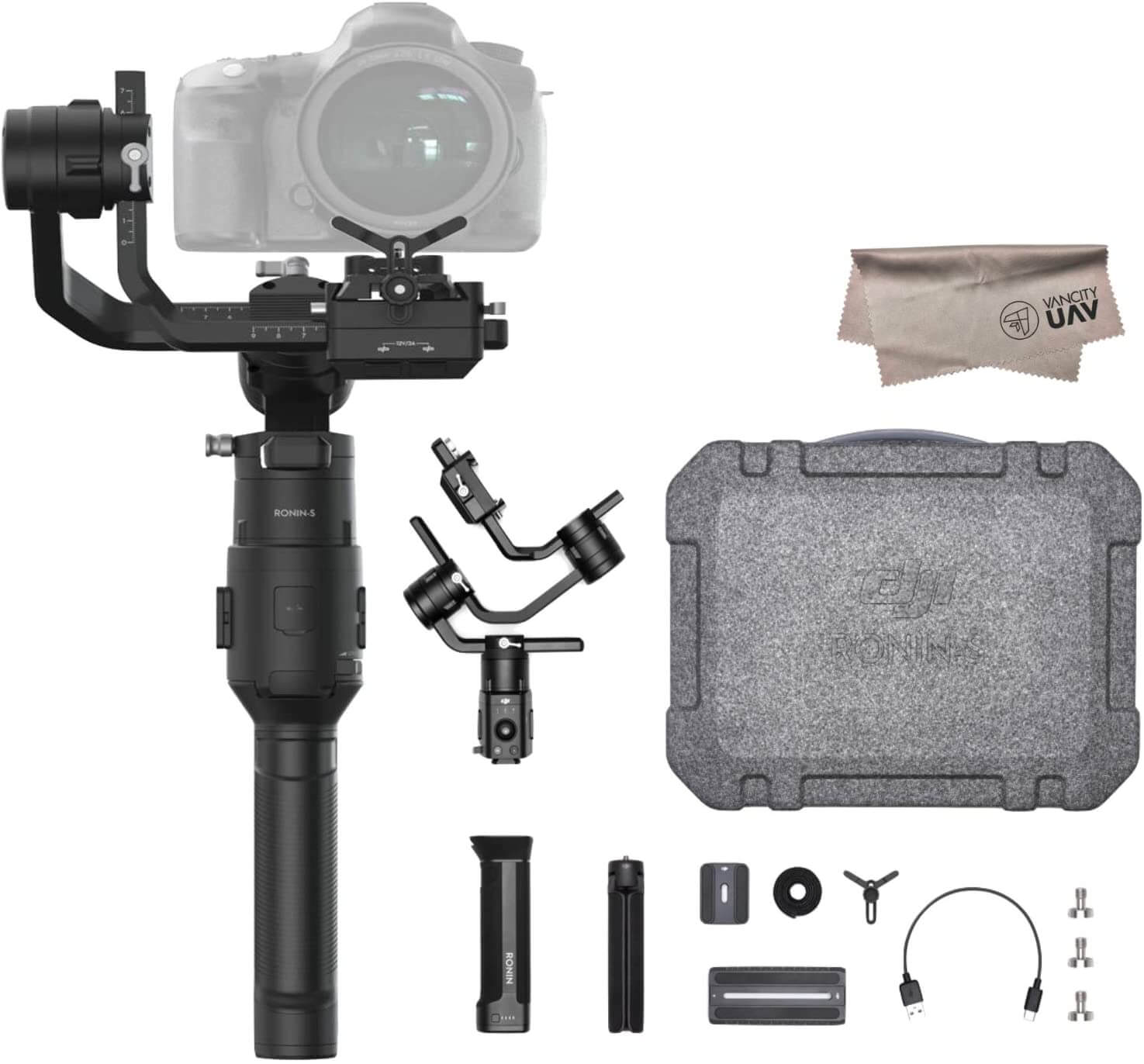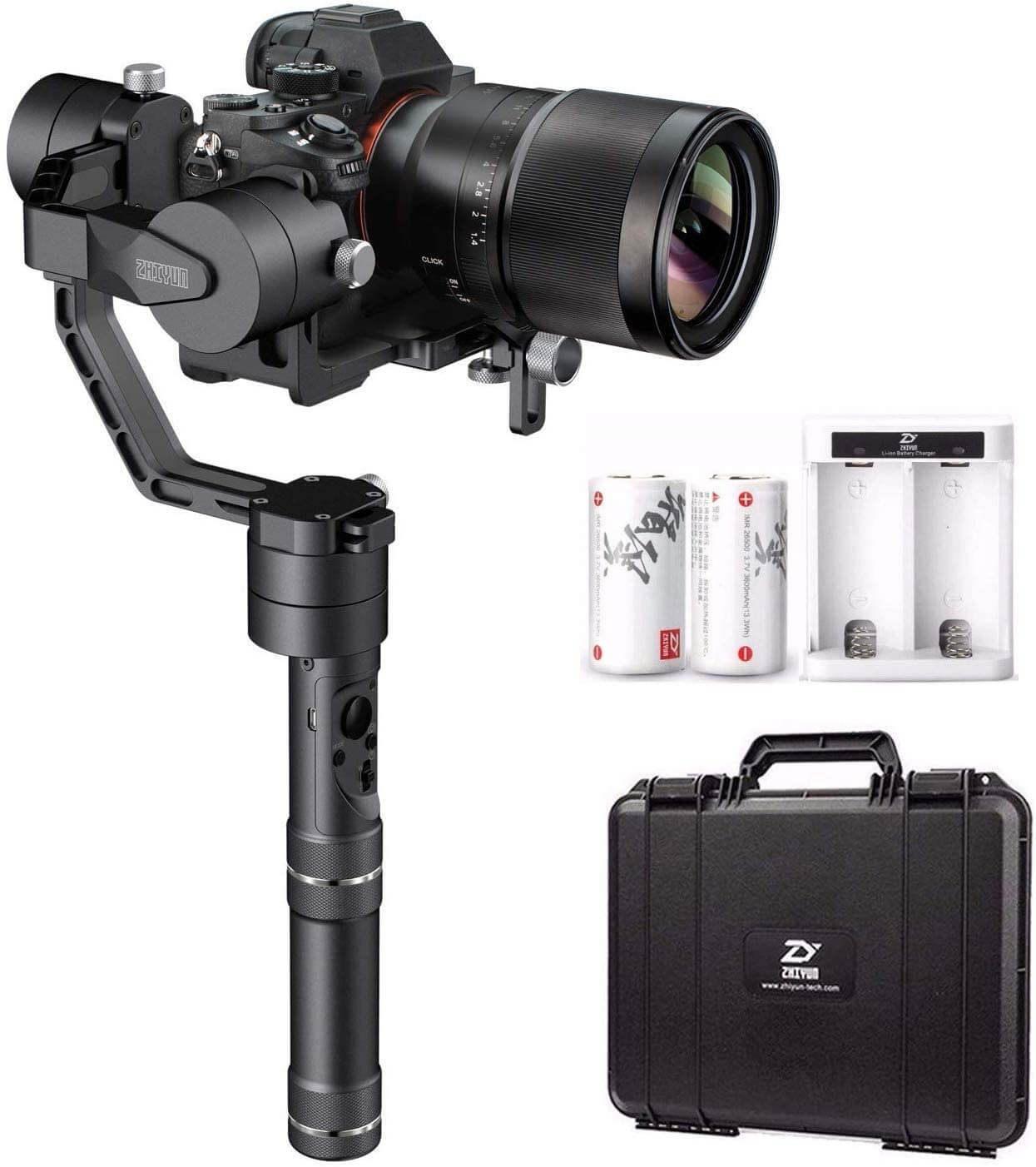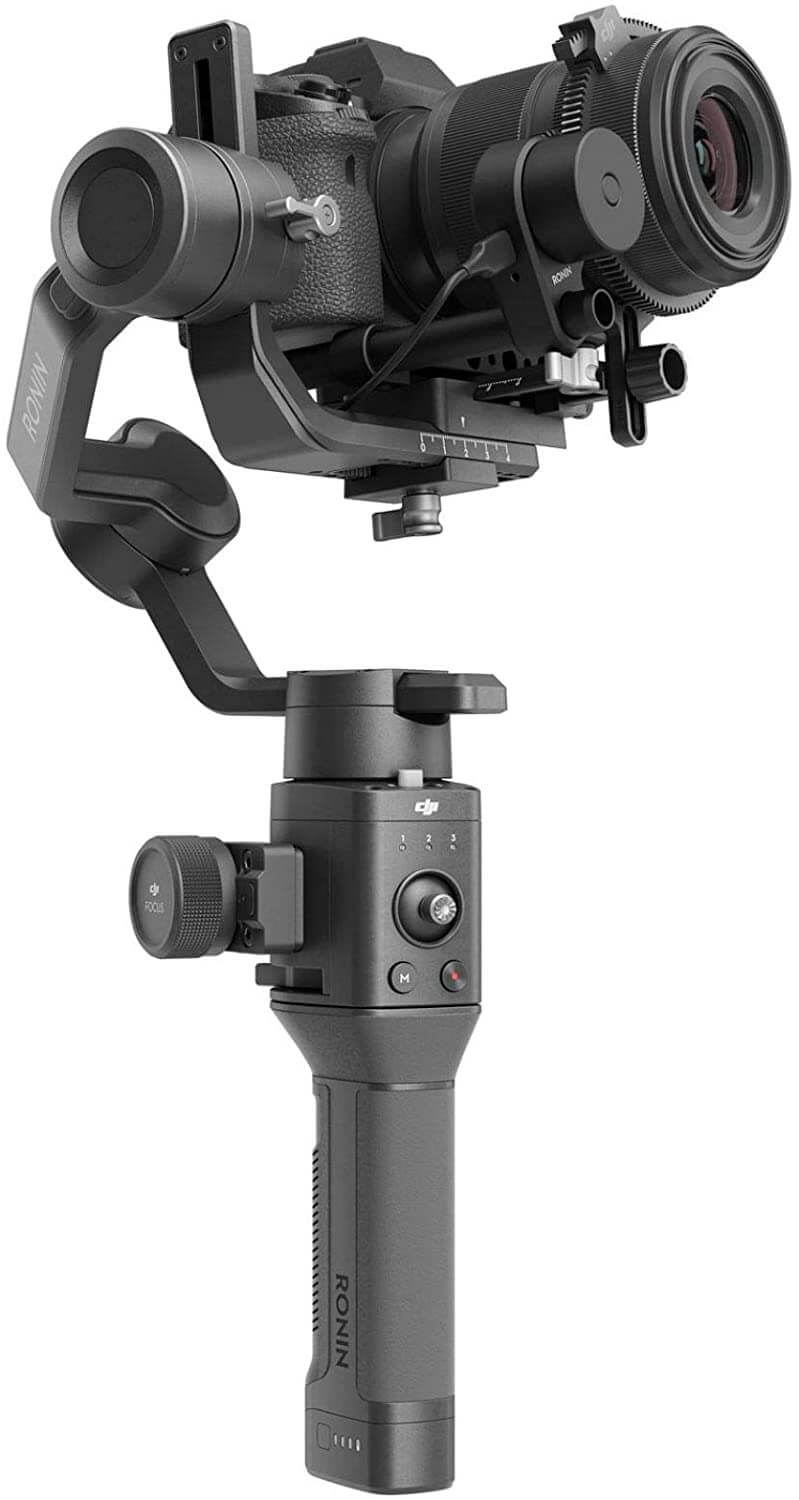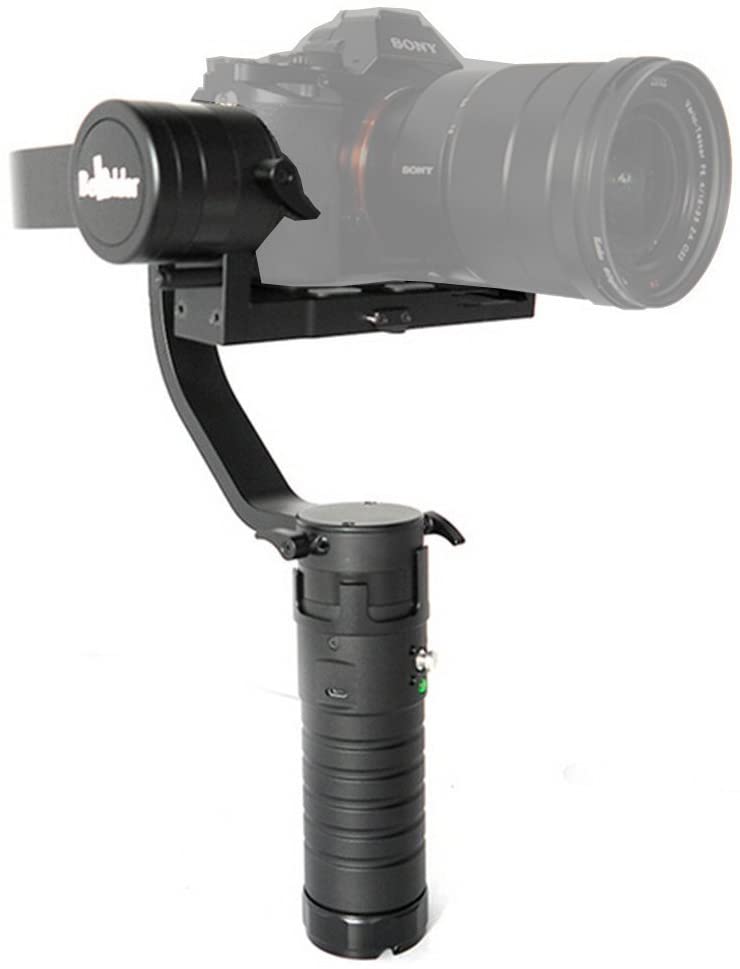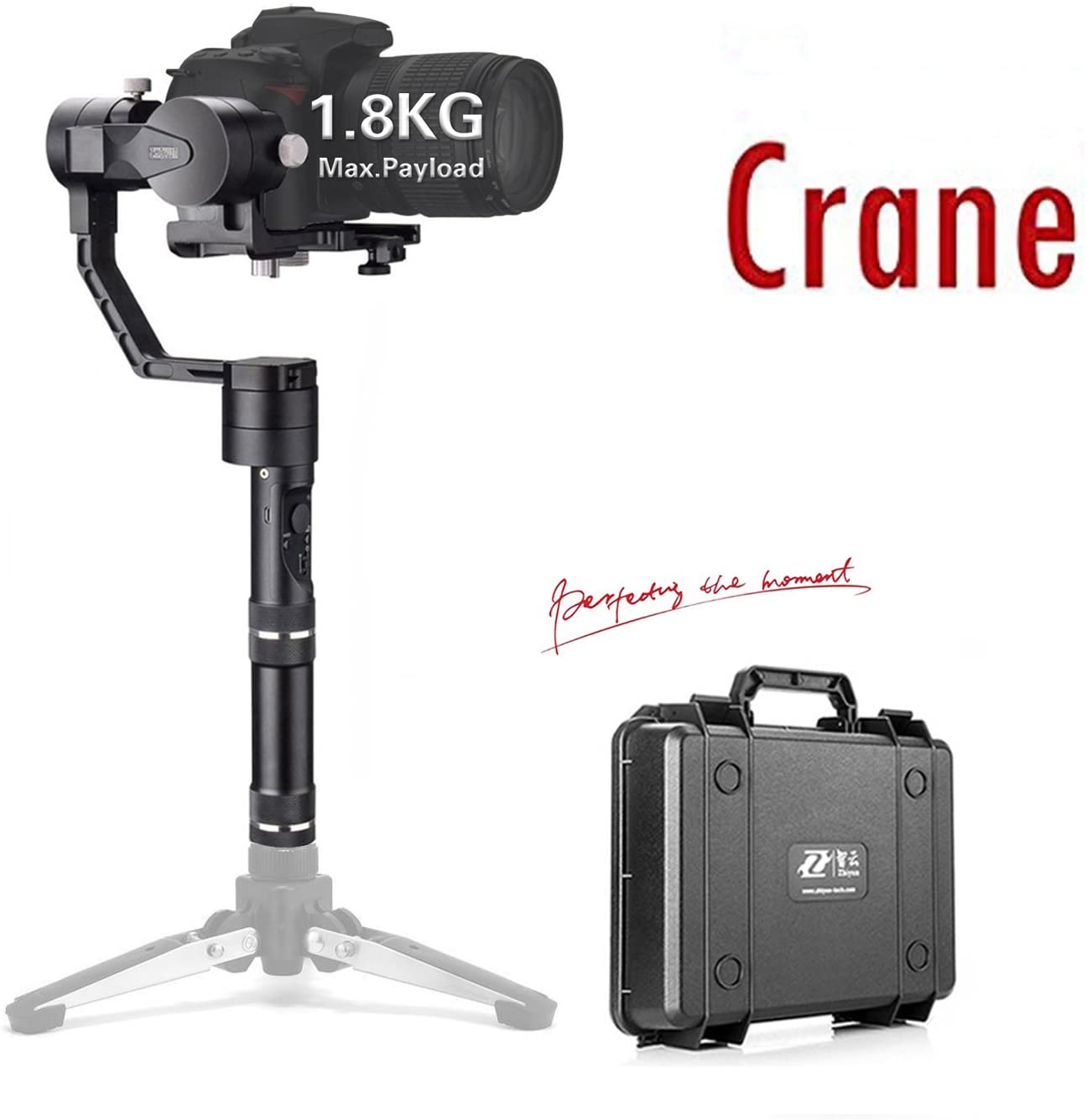Any film maker, whether you are an amateur or seasoned professional, understands the importance of achieving the perfect shot. Producing the beautiful visuals that set your content apart from all others is paramount to any videographer, and the equipment that you use could be the secret weapon in the creation of your film. If you want to capture the most striking visuals, utilising the highest quality tools can help you on your way.
If your goal is to film a setting while on the move and manually operating your own equipment, a high-quality gimbal may make your task so much easier. The ability to freely move and operate your chosen filming device without risking film blur or compromising the quality of your shot is invaluable. Considering features such as battery life, how much of a payload it can support, and how many different modes it offers, we can help you find the best DSLR gimbal.Best Pick
One of the highest quality gimbals in today’s market is the DJI Ronin-M V3, as its user-friendly design and robust frame make it a highly versatile gimbal for all sorts of filming situations. You can choose between its three filming modes, comfortably alternating between them to allow you to film in whatever filming styles best fit you.
Budget Pick
The Zhiyun Crane V2 is another option that could very easily be considered a top-quality choice of gimbal. It comes equipped with a responsive control dial and a long-lasting battery, priding itself on its ease of use. Its variety of features and accessories will also assure that you will never feel ill-equipped for any event you want to film.
Quick Comparison: Top 10 DSLR Gimbal for Filming and Videography
1. DJI Ronin-M Gimbal Stabilizer V3
If you’re looking for the mark of quality on your devices, we can very strongly recommend the DJI Ronin-M. The standout quality of this gimbal has to be its distinct ability to be portable and light, while sturdy at the same time. You can be assured of its durability, with its unique magnesium frame allowing it to support heavier cameras than you might expect.
We found its user-friendly design to be a real shot in the arm when it comes to choosing a gimbal, as it takes less than five minutes to set up and begin filming. The ATS technology that each Ronin-M comes equipped with will allow you to quickly place your camera onto the gimbal and start shooting with precision and certainty. For a gimbal with as many features as these, it’s worth pointing out that its size and weight will allow you to slip this device into a backpack or bag and travel easily without a second thought.
It comes equipped with Auto-tune Stability technology allowing for more precision with no extra tools needed, It also features various filming modes, allowing you to switch between Underslung Mode and Upright Mode, depending on the height you need to film, or Briefcase Mode if you’re filming at your side.Pros
Cons
2. Zhiyun Crane 2 Follow Focus 3-Axis Handheld Gimbal
Many of the most valuable features that the Zhiyun Crane 2 offers are based in convenience just as heavily as quality. You may consider this gimbal based solely on the sheer amount of value that it offers for such a powerful product.
The Crane 2 comes with a quick control dial that allows you to adjust your filming settings instantly, as well as an additional kit of cables included for connectivity to all of the top camera brands. You can switch freely between pan-following mode to easily track moving objects, POV Mode to more easily align with your line of sight, or selfie mode to capture yourself in the style of a vlog. We also were impressed by the slow-fall system, which protects your camera by slowing down how fast it falls off balance in the event of an unexpected power down.
The Zhiyun Crane 2 is ideal for customers looking to take the first step towards content creation or serious filming, providing a handy kit of additional tools without forcing you to pay a premium price. As a product however it also stands up to the more expensive options as an impressive product in its own right. If you are looking to pick up a high-quality gimbal without wanting to break the bank, the Zhiyun Crane 2 is a brilliant option to consider.Pros
Cons
3. FLYCAM Redking Quick Balancing Stabilizer
The first mechanical option on this list, the FLYCAM Redking possesses many features that may convince you to make the switch from an electric gimbal. Being entirely mechanical has its own list of pros and cons, as it removes the need for you to worry about buying new batteries or running out of power, yet at the same time requiring more moving parts that can introduce their own frustrations.
Its Sliding Dovetail Quick Release Plate makes setup and disassembly easier, and its set of control knobs and counterweights are versatile tools that can be very helpful if mastered. Its telescopic centre post is a robust support for the device that provides security while retaining an ergonomic design. One thing for you to keep in mind is that for a heavier camera, you will require heavier counterweights on the mechanism itself, which will increase the weight you have to carry, but ultimately you may find operating it more balanced than an automatic gimbal.
Being mechanical however means that there is more work for you as the operator to do that would have been performed electronically with other brands, which could be a blessing if you trust your hand more than a motor. But with a set of counterweights and individual pieces that could be misplaced or broken, the FLYCAM Redking may require a patient and experienced operator to truly get the most out of its many features.Pros
Cons
4. Zhiyun Weebill S 3-Axis Gimbal Stabilizer
The Zhiyun Weebill S is a very good suggestion if you’re looking for a specific niche of gimbal. It is a very light and small device, and suits a filming style that incorporates a great deal of movement.
You can alternate between upright and underslung positions, allowing you a greater range of control of how you record in filming situations that require precise movements. We found that these modes coupled with its lightweight frame make it an ideal gimbal for projects that take the most advantage of these traits. The Weebill S is also programmed with an 8th Instune Algorithm, which claims to improve the precision of recording objects moving quickly.
The trade-off that you should consider for a device of this size is that it is unlikely to support a heavier camera while still retaining the same precision that a lighter one would offer. We suggest that you consider this device as a specialised piece of equipment, one that perfectly fits the niche of recording faster objects with lighter cameras, but that you shouldn’t expect to perform as well if the ideal conditions are not met.Pros
Cons
5. MOZA Air 2 3-axis Gimbal Stabilizer
The Moza Air 2 offers a variety of features that you might find interesting, with a large variety of modes and accessories that may provide you with the perfect equipment for your next shoot. It also features a prominent time-lapse system that will allow you to make visually striking films in a variety of ways.
You have the ability to adjust the motor speed on the gimbal simply by rotating its built-in dial, and you can adjust between having the gimbal fully locked, or through the trigger you can adjust between eight different follow modes. Another helpful option is the ability to automatically calibrate the gimbal by holding the function button down upon bootup, allowing the gimbal to optimise its settings before filming.
It carries features that we’ve discussed on other gimbals, with an autotuned battery management system, as well the MOZA iFOCUS-M, a controller that allows you to freely manipulate the gimbal. These features in conjunction with the ability to control and input settings using the gimbal itself, rather than solely relying on the app, is a huge plus for anyone considering the MOZA Air 2.Pros
Cons
6. 2019 DJI Ronin-S 3-Axis Gimbal Stabilizer
The DJI Ronin S is a solid option for a heavier gimbal. We feel that it is best considered for outdoor use, as you might find more value in its high battery life, and the ease of movement you get from operating it single-handedly.
When linked with the DJI Ronin App, you can freely manipulate the device using your android or iOS device, which provides a great deal of comfort and autonomy. The Ronin-S also comes with a tripod stand and a USB option for charging and connectivity. However, despite these helpful features, we feel that the Ronin-S have a few shortcomings that need to be addressed.
Compared to other models, this device seems more difficult for novices to balance, considering the fact that it is heavier than most other gimbals and not as simple to set up for an inexperienced operator. The heavier weight also becomes a detriment when you realise that you can’t lock the motors during travel, which makes its ideal use of longer outdoor projects riskier to preserving the condition of the device.Pros
Cons
7. Zhiyun Crane V2 Handheld Gimbal Stabilizer
Another lighter and nimble product, the 2019 variant of the Zhiyun Crane V2 is a very useful addition to any of you beginner videographers, while also providing enough usefulness to be considered for a veteran. Compared to other models on this list, it takes less than a minute to balance the Crane V2 thanks to its patented thumb screw mounting, and its long runtime coupled with its easy-to-use app controller make it an easy tool to master.
This piece of equipment is compatible with the “Zy Play” app, which lets you configure the device while also being able to set your motor strength and follow speed, giving you a broader range of control for how you manipulate the gimbal. At the same time, its robust frame and ability to capture time-lapse footage, low angles and low exposure, features that are always useful but find extra value for the professionals that know how to make the most of it.
Its weight and payload suggest that the Zhiyun Crane V2 is most suitable for lighter and mirrorless cameras between 0.77 and 4lbs. If your equipment lines up with these conditions, you could be picking up an ideal gimbal for your circumstances.Pros
Cons
8. DJI Ronin-SC
We feel that the Ronin SC is a good selection for an entry level videographer or as a secondary piece of equipment, being easier to understand. You can run balance tests on the phone app, which we feel will be very helpful for you to understand how to balance a camera properly if you’re not experienced with it. It features its own tilt and roll axis to prevent any excess stray movements, and allows you to pre-set up to three shooting profiles that you can freely switch between while you work.
The features that the Ronin SC provide also seem fun to experiment with. Its tracking system lets you lock onto a target and let the gimbal follow that target closely, and its weight and build seem to be geared towards content creators and lighter jobs. It also allows you to link the gimbal with you iOS phone’s movements through its Force Mobile Mode, which we feel has a great deal of creative potential.
However, it doesn’t provide enough clearance to handle large lenses, being designed ideally for lighter cameras. If you’re working with a heavier duty DSLR camera, the Ronin-SC may not give you the convenience you are looking for. However, for content creation and lighter work, it might be an enjoyable option for you to consider.Pros
Cons
9. Beholder DS1 Handheld Stabilizer 3-Axis Brushless Gimbal
If your style of filming incorporates changing modes on the fly and relying on the versatility of your hardware, the Beholder DS1 is not for you. The most notable downfall of this product is the fact that it chirps loudly when changing modes. Not a dealbreaker for many film experts, but the loud noise could potentially ruin the quality of your footage, and requires an external program to fix.
In addition, the Beholder DS1 seems difficult to balance for people who aren’t familiar with it, with no alignment marks or memory. It is also quite limited in the range of cameras that are compatible with its specifications, only supporting up to 2kgs of weight.
For an industry in which precision and convenience are everything, the Beholder has a lot to offer, with a joystick to increase the precision of your tilting and panning, and impressive reviews about its battery life and compatibility. In the face of other gimbals however, the Beholder S1 has many shortcomings that a prospective buyer needs to be aware of.Pros
Cons
10. Zhiyun Crane V2 3-Axis Handheld Gimbal Stabilizer
The 2017 variant of the Zhiyun Crane V2 offers many of the same features as its previously mentioned 2019 counterpart. It is strong enough to support nearly any camera on the market, and is light enough to ensure that you won’t get tired shortly into filming. Cameras can be attached in a minute or less, as the process is simple and only requires a single thumbscrew and doesn’t need any tools.
It doesn’t come with an instruction manual however, although there are several handy YouTube videos which will fill you in on what you need to know. There are also occasions when the motors will struggle to keep up with cameras towards the heavier spectrum, but nonetheless it seems to be a very versatile product.
A slightly older model compared to the 2019 option, but a very handy piece of hardware that we feel seems easy to use and pick up, while still carrying enough features for a professional to make the most of.Pros
Cons
Benefits of Using a Gimbal
- More precision in difficult filming conditions
- Removes blur from a moving camera
- Allows you to capture more quality in your filming
- Maximises your camera’s ability to record clear footage
- Cheaper and more convenient for specific uses than other filming equipment
- Helpful to beginners and experts in filmmaking
What should you look for in a Gimbal?
There are so many different pieces of criteria for you to consider, and ultimately this can be a blessing in disguise for you. It will allow you to really consider what kind of gimbal you want, the purpose you want to use it for, and what features you are looking forward to taking advantage of.
Quality
When you’re looking to buy a DSLR Gimbal, the top priority should be placed on how easy to operate it is, while still retaining the utility and effectiveness of a top end product. If you’re in the field attempting to gain footage, it is unlikely that you will want the added headache of constructing a complicated device with multiple moving parts, or having to closely study the setup manual every time you attempt to use it. At the same time, to ensure that you achieve the most ideal results in filming, an effective gimbal should be versatile in its uses and quality in its execution.
With so many options on the market, how can you know the industry standard for a quality piece of equipment? Where one reviewer might sing their praises of a product, you may find others telling stories of faulty equipment or shoddy workmanship.
Weight and Payload
We know that choosing between a heavy duty or light gimbal can be difficult, as each option holds their own strengths and weaknesses. Do you want a device that is heavy and powerful, like a Hollywood director might use, or do you think a light, more dextrous gimbal is the better alternative?
If the device is too heavy, then you might struggle to carry it or hold it in place for long enough to film. In a profession where precision is key, you would ideally be able to operate it with little to no effort, to ensure that as little distraction as possible is present while filming. At the same time, making your gimbal too light could potentially damage your expensive equipment, as it needs to be able to endure the conditions it was designed for.
Ideal Settings
In environments that are confining or cramped like narrow pathways, dense crowds and unstable landscapes, a gimbal can provide a steady hand to your camera, allowing you to retain clarity and precision to your work.
If you’re recording in action, for example if you’re documenting a journey you might take as a tourist or explorer, a gimbal can make sure that your movements don’t spoil the clarity of your recording. Just this simple device can make any camera more versatile, as the fluidity of motion it provides will add an extra dimension to your film that other videographers will lack.
Modes
At first glance, when you look at a gimbal, your eyes might be drawn to the number of features it offers, and that makes total sense. You think to yourself “this gimbal has eight modes that I can film with! Why wouldn’t I buy this one?”
What you need to bear in mind is that the majority of consumers might not make the most of every feature. The Moza Air 2 for example comes with 8 follow modes and 4 pan modes that you can cycle through. For a professional that versatility might allow them to know which modes are ideal for which situation, whereas a more casual user may struggle to remember each mode and what they are best to be used for.
The bread and butter modes for a DSLR Gimbal are the upright and underslung modes. Upright has you operating the gimbal standing vertically, almost at eye level, and underslung positions the camera on the opposite axis, just below your waist. These options are the default filming options on most gimbals and they might be all you are looking for.
Some other gimbals offer flashier options, for example the ability to rotate the camera continuously in Inception Mode, and others like the Ronin SC have modes that can link the movement of the gimbal to your mobile device. Ideally you would consider the filming style that you would like to perform and choose the features you want based on what you know that you would use, in order to get the most out of your gimbal.
FAQ:
Can a Gimbal replace a tripod?
A tripod provides excellent stability for stationary filming, and can be carried if you need to reposition during filming. Tripods are very specialised pieces of equipment that can perform their functions very effectively, and in these situations could potentially perform the same role that a gimbal would.
However, any DSLR Gimbal of decent quality could offer so much more to a film than just stability through movement. The flexibility and versatility that a gimbal provides to adjust positions on the fly may offer so much more value for somebody who can make the most of it. A gimbal can fluidly adjust a cameras position in many situations where a tripod would be too rigid, and it can allow you to freely move or reposition yourself knowing that your footage won’t be ruined by the adjustments you make to your position.
When should I use a DSLR Gimbal?
Recording anything with a decent amount of dynamic movement or action is the specialty of a gimbal. Capturing footage similar to music videos, travel vlogs or any similar situations that require the person filming to move along with their subject and track their movements is what these devices are designed for.
Carrying a camera free hand while you record a moving object will almost definitely result in hasty hand adjustments or blurry footage, as our ability as human beings to be completely stable while moving is far inferior to the mechanical ability of a gimbal to provide this precision.
What are the best cameras to use with a DSLR Gimbal?
Ideally you would want to have a camera you are comfortable with first, and purchase the right gimbal that fits the specifications of that camera. Many of the higher quality gimbals can support cameras that weigh up to three or four kilograms.
Considering the main uses that you would find for a gimbal, we recommend cameras that are lighter and easier to manipulate, which will ensure that you can carry it on the gimbal for as long as possible before getting tired. At the same time, you want the filming camera to record at a high enough level of clarity to complement the precision that the gimbal provides. Mirrorless cameras or cameras that hold a smaller lens are great ideas to consider, as they provide the mobility you need from a camera without compromising on quality.
Our Verdict:
If you want the best DSLR gimbal and price is not an object, we can confidently recommend the DJI Ronin-M Gimbal Stabiliser V3, as its lighter weight may make the process of creating your perfect film that much easier. Its magnesium frame and ATS technology will provide that extra sense of precision with every movement, and between its three modes of motion, the Ronin-M will help you capture cinematic footage in settings that seem impossible to achieve footage in, which we believe is a quality worth the expense.
If you’re working on a tighter budget, we would recommend you go no further than the Zhiyun Crane 2 Follow Focus 3. It provides an impressive battery life, a convenient control dial and a range of motion options that are a bargain for the price they are charging.